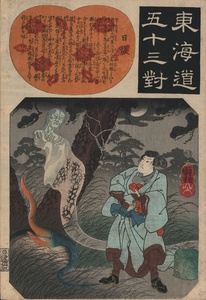| Method | Woodblock (nishiki-e) |
| Artist | Utagawa Kuniyoshi (1797-1861) |
| Published | 1845–46 |
| Dimensions | Ôban tate-e [~15.6 x 10.7 inches] |
| Notes |
Series: Tôkaidô gojûsan tsui: Fifty-three parallels for the Tôkaidô Road Signature: Ichiyûsai Kuniyoshi Artist seal: Kiri Publisher: Ibaya Senzaburô (Dansendô) Censor seal: Mura Reference: Schaap, Robert, Heroes and Ghosts (1998), pl.48, p. 73. An eerie scene of Nissaka: The Nightly Weeping Rock, Station 26, from Tôkaidô gojûsan tsui: Fifty-three parallels for the Tôkaidô Road, a series jointly designed by Hiroshige, Kunisada, and Kuniyoshi. The print tells the legend of the 'Nightly Weeping Rock', on the road between Edo and Kyoto. The legend concerns a pregnant woman travelling to Kanaya from Niisaka to meet her husband. During her journey she is attacked by a thief who murders her, her blood falling onto a nearby rock and becoming the home of her ghost. The rock was said to weep and cry out every night to passing people. In this print we see the sorrow-filled ghost of the woman appearing from the rock in front of her husband. The ghost has handed the husband their baby and his telling him of her fate. The Goddess of Mercy, Kannon, had saved the baby from a similar fate and kept them safe until he appeared. Utagawa Kuniyoshi (1797-1861) joined the famous Utagawa School, then headed by the great master Toyokuni Utagawa (1769 - 1825) at the age of fourteen. According to other sources, he had been trained by Katsukawa Shuntei before this. Kuniyoshi achieved his commercial and artistic breakthrough in 1827 with the first six designs of the series The Hundred and Eight Heroes of the Suikoden. The series was about one hundred and eight rebels and honorary bandits, based on an old Chinese novel from the fourteenth century. The story was very popular in Japan. The artist continued with this pattern of success and concentrated on print subjects of warriors and heroes. He was even nicknamed Warrior Print Kuniyoshi. After being financially settled, he turned to other subjects - ghost stories, comic prints, landscapes, beautiful women and actor prints. The artist also tried his luck with another subject, natural life prints, showing animals like birds, fish and cats. These kinds of new subjects, like the landscape print, had first been made popular by Ando Hiroshige. Since the early 1840s, Kuniyoshi prints show some influence of western style painting and printmaking. The artist possessed a collection of western engraving prints. He admired them as much as the European Impressionist artists would admire Japanese woodblock prints later. Western influence can be found in Kuniyoshi prints in several ways: the use of the Western perspective, the way he designed clouds and the way he tried to show the effects of light and shadow. Condition: Some rubbing and surface dirt to sheet. Album page remnants to verso corners. Small TSN red stamp to verso. |
| Framing | mounted |
| Price | £775.00 |
| Stock ID | 52980 |

